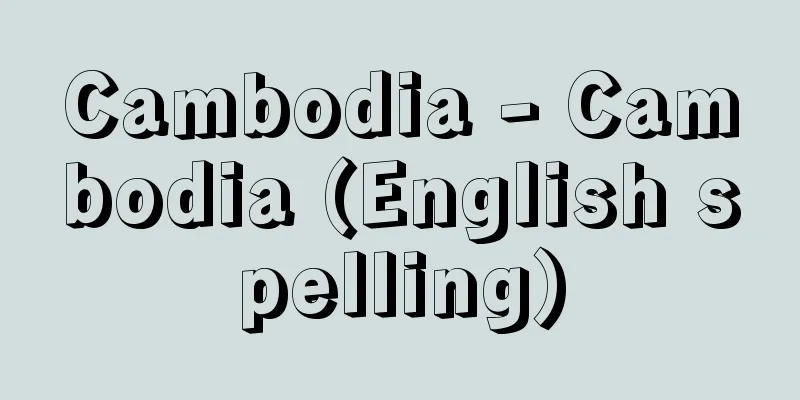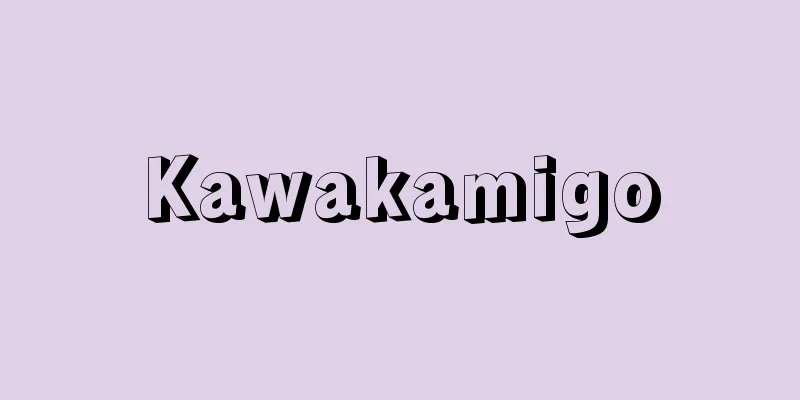Cambodia - Cambodia (English spelling)

|
A country located in the southeastern part of the Indochina Peninsula. It borders Vietnam to the east, Laos to the north, Thailand to the northwest, and the Gulf of Thailand to the south. Its area is 181,035 square kilometers (more than twice the size of Hokkaido), and its population is 13,388,910 (2008 census preliminary figure). Its official name is the Kingdom of Cambodia. In Cambodian (Khmer) it is called Reacheanachak Kampucher, in French it is called Royaume du Cambodge, and in English it is called Kingdom of Cambodia. Its political system is a constitutional monarchy. Its capital is Phnom Penh. [Shizuo Maruyama] Nature and ClimateThe country is located on the alluvial plain of the lower Mekong River, and is surrounded on three sides (northeast, north, and south) by mountain ranges. Although it is an alluvial plain, it is not uniform; the southeast is a lower, humid area of the lower Mekong River, while the northwest is a slightly higher, dry hilly area with less rainfall. Therefore, the southeast is prone to flooding, while the northwest is often plagued by no rain and drought. The central plain is dotted with hills and small mountains. These are called phnom, which means small mountain. Some are over 100 meters high, but most are only a few dozen meters high. The Mekong River often floods. When floods occur, the plains are immediately flooded. At such times, phnom provides a place of refuge. There are grass and trees there, so livestock can be kept, and firewood and charcoal can be obtained. It was an irreplaceable and important place for the people living on the plains. Originally, the tops of hills and mountains were considered sacred places where heaven and earth came into contact and merged, and where gods descended, so people built palaces and temples there. Cambodia is surrounded by a series of mountains and plateaus that surround the plains. The northeastern part of the country borders the Darluk and Kontum Plateaus of Vietnam and the Bolaven Plateau of Laos, and is at high altitude and densely forested. The plateau is covered with weathered basalt terroir (red soil). The Mondulkiri and Ratanakiri Plateaus along the border with Vietnam were considered a "sanctuary" by the North Vietnamese Army and the National Liberation Front of South Vietnam during the Vietnam War, and the Liberation Front Army attacked the Saigon government forces and the US Army from here. In the north, the Dangrek Mountains run east to west and form the border with Thailand. It is a long mountain range with an elevation of 200 to 550 meters and a length of 300 kilometers. The mountain range is made of sandstone, and elephants pulled the stones cut there to Angkor, from which Angkor Wat was built. Preah Vihear stands on the peak of the mountain on the eastern border of the mountain range. Although it is a small Hindu temple, its ownership was the subject of fierce fighting between Thailand and Cambodia in the late 1950s, and it was later decided that it belonged to Cambodia at the International Court of Justice in The Hague. The southern part of the country is made up of the Kardamoum and Elephant mountain ranges, and Mount Oral (1,813 meters) in the Kardamoum range is the highest peak in Cambodia. The Kirirom Plateau in the Elephant range is covered with dense jungle, and during the Sihanouk regime in the 1950s, a plan to settle 500,000 Japanese people was announced, which became a hot topic. At one time, the Khmer Rouge (Pol Pot faction) had a base in the Kardamoum range. The Khmer Rouge used the mountain range and plateau in the border area to carry out guerilla attacks on government army positions in the plains. Cambodia is so strongly influenced by the Mekong that it can be said that it was created by the Mekong. The Mekong runs almost north to south through the eastern part of the country. The water level of the Mekong is lowest in April, rises in May and June, and reaches 8 to 10 meters in September and October. This great river swells up during the flood season (rainy season), and the river cannot absorb the water by itself. However, if the water was discharged directly into the sea, the country would have to suffer from drought during the low water season (dry season). Therefore, during the flood season, the water of the Mekong flows back and enters the lowland plains, where it sits and forms a large lake, and gradually discharges water during the low water season. This naturally regulates the flow of the Mekong. This is the Tonle Sap Lake (meaning large lake). The Tonle Sap Lake is a large natural reservoir with a surface area of 3,000 square kilometers in the dry season and 10,000 square kilometers in the rainy season. The river that regulates the water flow between the rainy and dry seasons is called the Tonle Sap River. During the rainy season, Tonle Sap Lake overflows and engulfs the surrounding forests. This causes a large amount of plankton to grow, which in turn breeds fish and makes it a good fishing ground. The Mekong River is blocked by the Khon Falls near the border between Cambodia and Laos, but downstream, navigation is easy, and even large ships can travel from Kratie to Haikou all year round. The Mekong River, which collects water from Tibet, China, Myanmar (Burma), Laos, and Thailand, is controlled by the Tonle Sap Lake downstream in Cambodia, but its force is not limited to a single flow, and in Vietnam it splits into nine rivers (called the Kowloon River) and, as if its anger had finally subsided, it disappears calmly into the South China Sea. The climate is tropical monsoonal, divided into a dry season and a rainy season. The dry season is from November to April, and is dominated by the northeast monsoon. The rainy season is from May to October, and is dominated by the southwest monsoon. The amount of rainfall varies considerably from region to region, with the coastal areas along the Gulf of Thailand and the Kardamoum mountain range receiving 4,000 mm per year, and the inland plains receiving around 1,500 mm. The temperature is high throughout the year, with the monthly average difference between the highest in April and the lowest in December being only around 5°C. In Phnom Penh, the temperature exceeds 40°C in April, and the average annual temperature in the plains is 27-28°C. 53% of the country is covered by forests. There are many types of trees, and mangroves grow densely in the southern coastal areas. Since the 1990s, when the civil war ended, land development has progressed and the forest area has decreased, making resource conservation a challenge. [Shizuo Maruyama] History and Ethnic GroupsCambodia seems to have been inhabited in the Neolithic period, as evidenced by remains unearthed from shell mounds at Samrong Sen and Murpley. Later, Indonesian tribes settled in the basin from the Menam River to the Mekong River, and then Indian tribes invaded and mixed to become the Khmer people, the ancestors of present-day Cambodians. The Khmer people absorbed Indian culture, grew and expanded their influence, and founded the Funan Kingdom in Ba Phnom (present-day Prey Veng) around the 1st century. Its territory stretched from present-day southern Cambodia to Cochinchina, with Okeo as its outer port. People, trade, and cultural exchange with India had existed since before Christ, and even earlier. In ancient times, kingdoms that embraced Indian culture (Brahmanism, Mahayana Buddhism, funeral rituals, administrative and legal organizations, arts and crafts, agriculture and irrigation techniques) and flourished thanks to Indian culture included the Champa Kingdom, Dbāravati Kingdom, Srikshetra Kingdom, and Bagan Kingdom, and the first of these to be Indianized was Funan (1st to 6th century). Funan had become a powerful kingdom with influence over the surrounding areas by the end of the 5th century, but was soon replaced by the Zhenla Kingdom (6th-8th century) which was established there by a feudal lord sent to Champasak in southern Laos. The Zhenla Kingdom later split up, and was reunited to form the Angkor Kingdom (9th-15th century). The country flourished most during the reigns of Jayavarman II (reigned 802-850; the first king was Zhenla, reigned from about 657 to 687), Suryavarman II (date of birth and death unknown; reigned about 1113-1150), and Jayavarman VII (1181-1218), whose territory extended from central and southern Vietnam in the east to central Laos in the north, the lower reaches of the Menam River in the west, and the northern part of the Malay Peninsula in the south. The kingdom flourished in maritime trade, started irrigation projects, built cities and temples, and allowed Indian culture to flourish. Representative ruins include Angkor Wat, Angkor Thom, and Banteay Srei. However, the kingdom was exhausted by the construction of magnificent cities and temples, large-scale water projects, and epidemics, and gradually lost its vitality. Thai peoples and Burmese peoples from the north moved south along the Mekong, Menam, Salween, and Irrawaddy rivers, and established kingdoms in various places from the 13th to the 15th centuries. These included the Aba Kingdom in central Burma, the Lanna Thai Kingdom in northern Thailand, the Sukhothai Kingdom in central Thailand, and the Ayutthaya, Thonburi, and Bangkok Kingdoms in southern Thailand. These were a serious threat to the Angkor Kingdom. The Yuan Dynasty (Mongol) also invaded (Mongol invasions). The Yuan Dynasty invaded Korea, Japan, Java, Burma, Vietnam, and Champa, but invaded Cambodia in 1283. Each country was forced to fight fiercely. Thus, the Indianized kingdoms collapsed one after another, and in 1431 the Angkor Kingdom abandoned its capital, Angkor, and moved to Phnom Penh. After that, internal conflicts over succession to the throne continued, and there were repeated invasions by Siam (the Ayutthaya Dynasty) and Vietnam (the Nguyen Dynasty), making Cambodia a battlefield for fierce competition between the two countries. Cambodia turned to France for help, attempting to gain security by becoming a French protectorate, and a protectorate treaty was concluded with France in 1863. France took advantage of this to strengthen its influence, and in 1887 incorporated Cambodia into the "Federation of French Indochina." This was the colonization of Cambodia by France. France recognized the monarchy and allowed it to continue, but this was only in name, and in reality they attempted thorough Frenchification, appointing a French chief commissioner at the top and placing French commissioners in various regions. During the Second World War, France was recognized as the sovereign over Cambodia, Vietnam, and Laos under the pretext of joint defense between Japan and France (the "French-Japanese Protocol for the Joint Defense of French Indochina" was signed in July 1941), but in March 1945 Japan disarmed the French troops and placed Cambodia, along with Vietnam and Laos, under sole Japanese control, granting it nominal independence (March 11 in Annam, March 13 in Cambodia, and April 8 in Luang Prabang). At the time, the king was Norodom Sihanouk, who remained as king, and Son Ngoc Thanh (1908?-1977/1982), who had fled to Japan, was appointed prime minister. However, with Japan's surrender, the independence government vanished like a bubble. Afterwards, there were various independence movements led by communists, republicans, and royalists, but Sihanouk held the leadership and the monarchy continued. After enacting a constitution in May 1947 and declaring Cambodia a constitutional monarchy, Sihanouk persistently negotiated independence with France, winning independence within the French Union in November 1949, judicial and police powers in August 1953, and military power in October of the same year, achieving complete independence. The main ethnic group is the Khmer, who make up 90% of the total population. Ethnic minorities include the Cham (who settled in Cambodia after the fall of the Champa Kingdom, and many of them work in fishing around the Tonle Sap Lake), Lade, Giarai, Stien, Quy, and Pia, as well as many Vietnamese (overseas Vietnamese) and Chinese (overseas Chinese). The Chinese have taken root in Cambodia since the French colonial period, and have a monopoly on the commerce and distribution sectors. [Shizuo Maruyama] Political and governmental transitionsSince independence, the political situation has changed rapidly, with successive changes of government. [Shizuo Maruyama] First Period: Sihanouk Monarchy (October 1953 - March 1970)Cambodia gained complete independence in October 1953, but the following year, with the signing of the Geneva Accords (Indochina Armistice), Cambodia's status as an independent nation was internationally recognized, and the Sihanouk regime was established. Sihanouk organized a pro-government party, Sankhum (People's Socialist Community), and based on the protection of the monarchy, Buddhist faith, and neutral diplomacy, he attempted to unify the country, restore peace, and promote economic and social development. However, finances deteriorated, Sankhum split into left and right factions, and anti-government plots and rebellions occurred one after another. Sihanouk tried to prevent Cambodia from being drawn into the Vietnam War by maintaining a neutral diplomacy, but the right wing criticized it as a pro-communist policy, and the North Vietnamese Army and the National Liberation Front of South Vietnam took advantage of this to infiltrate the eastern border area, set up there, and fought the Vietnam War as a sanctuary. As the war expanded, the sense of crisis grew and the right wing rose to power. The Sihanouk regime was cornered. [Shizuo Maruyama] Second Period: Lon Nol Republic Era (March 1970 - April 1975)In January 1970, Sihanouk went to France for medical treatment. During his absence, on March 18, a joint session of the National Assembly and the Royal Assembly resolved to dismiss him as President. It was a coup by the Lon Nol faction. Cheng Heng (1910-1996, assumed the position of President on March 21, 1970) became the new Acting President, and Lon Nol (1913-1985) became Prime Minister. On October 9, 1970, the monarchy was abolished and a republic was proclaimed. The pro-American government of the "Khmer Republic" came into being. Lon Nol then became President on March 10, 1972, replacing Cheng Heng, and President on March 13. In response, Sihanouk, who was in Beijing after a trip to France and the Soviet Union, immediately established a new government in Beijing. The new government was made up of the National United Front of Cambodia (FUNK), the Government of the National Union of the Kingdom of Cambodia (GRUNC), and the National Liberation Army (commanded by Khieu Samphan), and called for the overthrow of the Lon Nol regime. In response, a battle with the Lon Nol army began in the country. The central force in the battle was the Khmer Rouge. The Khmer Rouge was the Cambodian communist party, and had been engaged in anti-government activities since the time of the Sihanouk monarchy, but now they responded to Sihanouk's call. The Khmer Rouge gained weapons and equipment with the aid of China and North Korea, which gave them an advantage in the battle. The US military and South Vietnamese government forces invaded Cambodia in May 1970. They tried to drive the North Vietnamese Army and the National Liberation Front of South Vietnam forces out of the eastern region and prop up the Lon Nol regime. However, the war expanded and the military situation became unfavorable for the Lon Nol regime. Eventually, the Khmer Rouge expanded its influence and came to control most of the country. A major turning point came when the Vietnam Peace Accords were signed in January 1973, and the United States ceased combat operations in Cambodia in August of the same year. In April 1975, the Lon Nol regime was overthrown, and the Khmer Rouge liberated Phnom Penh. [Shizuo Maruyama] Third Period: Pol Pot Communist Dictatorship (April 1975 - January 1979)After taking control of the whole country, the Khmer Rouge held the Cambodian People's Congress in Phnom Penh in April 1976 and proclaimed the establishment of a new state. The new state was named "Democratic Cambodia" and elected Khieu Samphan as head of state and Pol Pot as prime minister. The government set out new policies including the abolition of private property, collective ownership of the means of production, abolition of currency, denial of the commodity economy, and mobilization of the entire population for agricultural labor. This envisioned the construction of a state based on a unique ideology that could be called primitive communism with agriculture as its main focus, and advocated thorough egalitarianism, the reform of people and society, and the denial of the old order (the abandonment of old values). Pol Pot said, "Our new society has no model. This is a new society without a model." Almost all those who did not follow the new nation-building were eliminated. According to the Cambodian People's Revolutionary Tribunal, which the Heng Samrin regime opened in Phnom Penh in August 1979, the total number of people killed under Pol Pot's regime was three million, and of the survivors, more than four million suffered serious physical and mental injuries. China, which was carrying out the Cultural Revolution, supported the Pol Pot Revolution as an overseas version of the Cultural Revolution. Vietnam had a strong distrust for the regime. Cambodia-Vietnam relations deteriorated, the border dispute between the two countries intensified, and on December 23, 1978, Pol Pot's army launched an all-out attack on Vietnam. On December 25, the Vietnamese army launched a counterattack and repelled the Pol Pot army, and the Pol Pot regime collapsed in January 1979, with the Pol Pot army retreating into the Kardamoum mountain range. [Shizuo Maruyama] 4th Period: The Heng Samrin Regime and the Era of International Political Warfare (January 1979 - October 1993)As soon as the Khmer Rouge was driven out by the Vietnamese army, the People's Republic of Cambodia was established in Phnom Penh in January 1979 with strong Vietnamese backing. This was the appearance of a pro-Vietnamese government. The Prime Minister was Heng Samrin, who had been a battalion commander in Pol Pot's Eastern Army and later left the Khmer Rouge. With the full support of Vietnam, the Heng Samrin government worked to restore law and order, stabilize society, and rebuild the country from the war damage. In June 1981, the National Assembly was held and a new constitution was adopted, with Heng Samrin as Chairman of the National Council and Pen Sovan (1936-2016) as Prime Minister. In October 1985, Heng Samrin was re-elected and Hun Sen was elected Prime Minister. The area of control gradually expanded to cover almost the entire country, and the Heng Samrin regime was established. The ruling party was the Cambodian People's Revolutionary Party, led by Secretary General Heng Samrin, which later changed its name to the Cambodian People's Party (CPP), and its leader was Chea Sim (1932-2015). In response, the Khmer Rouge moved from the Kardamoum mountain range to the Thai-Cambodian border, where they established a base and continued their guerilla resistance. Democratic Kampuchea consisted of three groups. One was the Khmer Rouge (National Unified Democratic Patriotic Front, Chairman Khieu Samphan, Vice Chairman Son Sen (1930-1997)), the other was the Son Sann faction (National Liberation Front of Cambodian People = FNLPK, Chairman Son Sann (1911-2000)), and the third was the Sihanouk faction (National United Front for an Independent, Neutral, Peaceful and Cooperative Cambodia = FUNCINPEC, led by Sihanouk's son Norodom Ranariddh (1944-2021)). In July 1982, the three factions agreed to form a coalition government, and the Coalition Government for Democratic Kampuchea (GCKD) was established. The president was Sihanouk, the vice president was Khieu Samphan, and the prime minister was Son Sann. The confrontation between the Heng Samrin faction and the Khmer Rouge was also a confrontation between Vietnam and China, and Thailand and Vietnam, but before long, the Soviet Union and Eastern European countries sided with the Heng Samrin regime, while China, Thailand and other ASEAN (Association of Southeast Asian Nations), the United States and Japan sided with the Khmer Rouge, and it began to take on the flavor of an international political battle. Representation in the United Nations was always given to Democratic Cambodia. [Shizuo Maruyama] General election and its aftermath (May 1993~) Peace negotiations and peace talks to end the civil war were held in various forms from July 1987 in Paris, Jakarta, Bangkok, Phnom Penh, Tokyo, New York, and other locations. In September 1990, the parties and interested parties agreed to a comprehensive peace plan proposed by the UN Security Council, and in October 1991, the "Agreement on a Comprehensive Political Settlement of the Cambodian Conflict" (Paris Peace Agreement) was signed in Paris. The contents of the agreement were as follows: Thus, the reconstruction of the nation progressed, but the conflict between the faction of First Prime Minister Ranaritt and that of Second Prime Minister Hun Sen intensified, and on July 5 and 6, 1997, Hun Sen mobilized the national army to wipe out the pro-Ranaritth security forces and his supporters. ASEAN considered this a coup d'état and decided at an emergency meeting of foreign ministers on July 10 to postpone Cambodia's ASEAN membership. On August 6, the Cambodian National Assembly elected Ung Huot (1945- ) as First Prime Minister, replacing Ranaritt. Hun Sen gained control of the police, military, and local administration, and thus gained the upper hand. In July 1998, Cambodia's first general election was held, with 64 of the 122 seats in the National Assembly won by the CPP, 43 by FUNCINPEC, and 15 by the Sam Rainsy Party (SRP, a FUNCINPEC splinter group that was renamed the Khmer National Party). Hun Sen's CPP became the largest party, but it did not have the two-thirds of the seats required by the constitution to form a cabinet, so it tried to win the remaining 18 seats by forming a coalition with other parties. In response, FUNCINPEC and the SRP appealed for the invalidation of the election, intensifying their confrontation with the Hun Sen faction. However, the majority of the international community accepted the election, and in November of the same year, with the mediation of Sihanouk, a coalition government was formed with Hun Sen of the CPP as prime minister and Ranariddh of FUNCINPEC as speaker of the National Assembly. With the establishment of a 61-seat Senate in Cambodia in March 1999, ASEAN considered Cambodia to have completed its normalization after the political upheaval, and in April of the same year, Cambodia officially joined ASEAN. In the general election of July 2003, the CPP won 73 seats and became the largest party, but negotiations over the formation of a cabinet dragged on, and a coalition cabinet was finally formed in July 2004 with Hun Sen as prime minister. In October of the same year, Sihanouk abdicated and his son, Sihamoni, became the new king. In the general election of July 2008, the ruling CPP won 90 seats, and deputy leader Hun Sen continued to serve as prime minister. Meanwhile, the Khmer Rouge split up, with members defecting one after another and declining in power. Pol Pot was captured and died in April 1998. Furthermore, in March 1999, the Chief of Staff Ta Mok (1926-2006), who had been the only remaining resistance, was arrested by the government, and the Khmer Rouge was completely destroyed. Ta Mok died in July 2006. In the same year, a special tribunal was established with the support of the United Nations to try the Khmer Rouge for the genocide of their own people, and trials began in February 2009. Cambodia was exhausted by a long civil war, its land was devastated, and it suffered from the corruption of power. For a great nation with a glorious history, the chaos caused by the civil war was all the more tragic. [Shizuo Maruyama] Parliament and MilitaryThe National Assembly is a bicameral system, with the 61-seat upper house and six-year terms, and the 123-seat lower house, the National Assembly, with five-year terms. A constitutional amendment in 2006 changed the number of seats in the lower house required to form a cabinet from two-thirds to a simple majority, and the highest-ranking member of the lower house who belongs to the political party with the majority of support is appointed prime minister and forms a cabinet. The military has an estimated total strength of 124,300, including 75,000 in the Army, 2,800 in the Navy, 1,500 in the Air Force, and 45,000 in state and local troops. Industry and EconomyCambodia's main industry is agriculture, with 68.2% of the employed population (including fisheries and forestry) working in agriculture (2005). The main agricultural product is rice, with rice paddies accounting for about 90% of all cultivated land. However, extensive farming without fertilizer has the drawback of being vulnerable to weather, and agricultural production dropped significantly due to the civil war in the 1970s, resulting in food shortages. In 1994, rice production was 1.8 million tons, a low figure that was on a par with Laos in Southeast Asia. However, in 1995, yields gradually recovered, and exports resumed. In 2002, it had recovered to 4,099,000 tons, and in 2007, it had recovered to 5,995,000 tons. The fishing industry is centered on Lake Tonle Sap, with a total catch of 112,510 tons in 1995 and 483,000 tons in 2006. Industry was completely abandoned as the Pol Pot regime adopted an extremely agricultural, proto-communist policy, but it has begun to recover, particularly in the garment industry. The long civil war put a strain on the economy. Trade consists of exports of garments, rice, rubber, and corn to the United States and other Asian countries, and imports of various industrial products from Asian countries. In 2000, exports totaled $1.05 billion, while imports totaled $1.43 billion, resulting in a constant trade deficit. 40% of the 1997 budget was provided by aid and loans from international organizations such as the International Monetary Fund (IMF) and the World Bank. Since 2000, the economy has continued to grow, with a growth rate of over 10% from 2004 to 2007. In 2007, the gross domestic product (GDP) was $8.619 billion, and the per capita GDP was $594, for an economic growth rate of 10.1%. Trade volume was $4.236 billion in exports and $5.609 billion in imports, both of which are about four times larger than in 2000. The main export items are sewn products, fabrics, natural rubber and rubber products, etc., while the import items are fabrics used as raw materials for sewn products, petroleum products such as gasoline, diesel, and heavy oil, home appliances, vehicle parts, etc. The main export destinations are the United States (53.3%), Hong Kong (13.1%), Germany (5.2%), and the UK (4.2%), while the main import destinations are Hong Kong (19.3%), China (17.7%), Thailand (14.4%), and Taiwan (10.8%). The roads total length is approximately 33,700 km, of which just under 80% are unpaved. The railway connects Sisophong and Kampong Som (Siahnoukville) from Phnom Penh, with a total length of 603 km. The sea port is Kampong Som 1 port. The water transport is 3,000 to 4,000 tonnes-class ships, and you can travel back to Phnom Penh. There are international airports in Phnom Penh and Siem Reap, and regular flights are available to Ho Chi Minh, Bangkok, Singapore, and other locations. [Shizuo Maruyama] Society and Cultureになったんです。 English: The first thing you can do is to find the best one to do. This is truly a microcosm of history. However, the Cambodian society we see today is a rough, poor world where people live by rough agriculture. That is why the greatness of Angkor civilization struck a man's heart. The ruins are represented by Angkor Wat, Angkor Thom, and Banteai Surei. Angkor means city, Wat means temple, and Angkor Wat means the city with temples. It is a typical Hindu temple, the largest in Southeast Asia. It was mainly built by Sur Yabarman II, and it took 70 years to complete. Angkor Thom's Thom means big, Angkor Thom is a great city. It was built by Jayabarman VII. VII was an avid Buddhist, and the temple in Bayon, which forms the center of Angkor Thom, is a Buddhist temple. Banteai Surei means women's fortress. It was built around 676 by Yajnabaraha. The architectural style of temples and temples representing the Angkor ruins is said to be an attempt to symbolize mountains. Mountains mean Mount Sumeru, which is considered the center of the world. The surrounding walls of temples and temples represent the Himalayas, while the moats and the earth represent the oceans, and the universe is expressed there. Angkor Wat is a microcosm of the universe. Gods descend on the mountains, where humans interact with each other, that is, gods and the king, who is the representative of human society, are combined. In the mountains, the universe of nature and the small world where humans live. From there, the king is considered the incarnation of God, and the authority of the king is orchestrated. Temples and temples were places of "eight" that mean the existence of the king and prove the ideological and philosophical basis for being a king. In addition to fighting, the corridors lively depict the lives of the people of the time, from craftsmen, carpenters, peddlers, chefs, dog fighters, cock fighters, shogi players, people who work at construction sites, and market sellers and buyers. The power of the heavy nature of Encore architecture overwhelms those who see it, the exquisite and delicate decorative sculptures strongly attract people, and the generous lives of the common people calm the heart. At the same time, the history, ideas and philosophy expressed in stone art make people think deeply. Bayon's huge Buddha face praises a heavy, dark, and rather mysterious expression, perhaps because he feels uneasy about the future of this dynasty politics. Educational facilities were completely abolished during the Pol Pot era, but then revived. In 2001, the number of students reached approximately 2.71 million elementary schools, 470,000 junior high schools, and approximately 8,400 universities, with a literacy rate of 76.3% (2007). The education system is six, three, three, three (6th grade elementary school, third grade junior high school, and third grade high school), and compulsory education is from six to nine years of age. There are 20 daily newspapers, one state-run radio station and one television station, as well as private radio and television stations. The majority of the residents are Hinayana Buddhists, and boys enter temples and undergo tempura training when they reach the age of 11 or 12. It is said that there are 2,800 temples and approximately 8.2 million Buddhists (1994). The official language is Cambodian (Khmer), and it has its own Khmer character. [Shizuo Maruyama] Relations with JapanThe Japanese people traveled abroad frequently during the Azuchi Momoyama period (1573-1598) and the early Edo period (1598-1639), and the towns of Japan were founded all over the South Sea. In Cambodia, there was a Japanese town in Phnom Penh and Pinyar, about 20km up the Tonle Sap River from Phnom Penh. The town of Pinyar had 70 to 80 homes, and the number of residents was 200 to 300. The town of Japan was recognized for a kind of autonomy, and the mayoral mayor was chosen among the Japanese people, and the supply was purchased and shipped widely, and funerals and events were also held in accordance with Japanese traditions. All the townspeople attended the wedding of the influential mayor, and Cambodian princesses and ministers attended a grand celebration.になったんです。 English: The first thing you can do is to find the best one to do. During the Pacific War, Japan carried out Operation Ming, disarmed the French army, put French Indochina under Japan's sole control, and sent troops to Cambodia. This was the opportunity to "permit" independence in Cambodia, and established the Kingdom of Cambodia on March 13, 1945 (King Sihanouk, Prime Minister Son Gok Tan). However, with Japan's defeat, independence disappeared. になったんです。 English: The first thing you can do is to find the best one to do. Since 1992, Japan has been the largest supporter of Cambodia. In 2006, Japan's aid (representation of support) to Cambodia was $114.7 million, a far cry from the US $61.8 million, France $38.2 million, and Australia $31.8 million. In terms of trade with Japan, exports amounted to approximately 16.3 billion yen and imports amounted to approximately 13 billion yen (2007). The main export items are shoes, clothing and accessories, bags, electrical measuring equipment, and imported items include transportation equipment, sewing machinery, general machinery, and electrical equipment. [Shizuo Maruyama] になったんです。 English: The first thing you can do is to find the best one to do.になったんです。 English : The first thing you can do is to find the best one to do . "Yagura Kenjiro, "Poverty and Inequality in Rural Cambodia" (2008, Showado)" ▽ "Global Norms/Local Politics: The Future of Democracy" (2008, Sophia University Press, published by Gyosei)" [Reference items] | | | | | | | |Khmer| | | | | | | | | | | | | [Complete Materials] |Source: Shogakukan Encyclopedia Nipponica About Encyclopedia Nipponica Information | Legend |
|
インドシナ半島の南東部に位置する国。東はベトナム、北はラオス、北西部はタイに接し、南はタイランド湾に臨む。面積は18万1035平方キロメートル(北海道の2倍強)、人口は1338万8910(2008センサス速報値)。正称はカンボジア王国。カンボジア語(クメール語)ではReacheanachak Kampucher、フランス語ではRoyaume du Cambodge、英語ではKingdom of Cambodia。政治体制は立憲君主制。首都はプノンペン。 [丸山静雄] 自然・風土国土はメコン川下流域の沖積平野に開け、三方(北東部、北部、南部)を山系で囲まれる。沖積平野といっても一様ではなく、南東部はメコン川下流域の、より低い湿潤地帯となり、北西部はやや土地が高く降雨の少ない、乾燥した丘陵地帯となる。したがって南東部は水の氾濫(はんらん)に、北西部はしばしば無雨・干魃(かんばつ)に悩む。中央部の平地には点々と丘や小山のような高所がある。これをプノンという。小山という意味である。100メートルを超える高さのものもあるが、だいたいにおいて数十メートルの高さである。メコン川はしばしば氾濫する。氾濫となると、平地はたちまち水浸しとなる。そのとき避難場所を提供してくれるのがプノンである。そこには草と木があって家畜を飼うことができたし、また燃料用の薪炭も得られる。平地に住む人たちにとってかけがえのない大事な場所であった。もともと丘の上や山頂は、天が大地と接触し天地が融合する所で、神々が降臨する神聖な場所とされ、人々はそこに宮殿、寺院を建てた。 カンボジアは平地を取り囲む形で周囲に山系、台地が連なる。北東部はベトナムのダルラク高原、コントゥム高原、ラオスのボロベン高原に接して標高は高く、森林も濃密である。台地には玄武岩の風化したテル・ルージュ(紅土)地帯がある。ベトナム国境沿いのモンドルキリ、ラタナキリ高原はベトナム戦争期、北ベトナム軍と南ベトナム解放民族戦線軍によって「聖域」とされ、解放戦線軍はここから出撃してサイゴン政府軍、アメリカ軍を攻撃した。北部はダンレック(ドンレク)山脈が東西に走ってタイとの国境をなしている。標高200~550メートル、延長300キロメートルの長い山系である。山系は砂岩からなり、そこで切り出された石をゾウがひいてアンコールに運び、それによってアンコール・ワットは建造された。山系の東部国境地帯の山頂にはプレア・ビヒアPreah Vihearが建っている。小さなヒンドゥー寺院だが、1950年代後半、その帰属をめぐってタイ、カンボジア間で激しく争われ、のちハーグの国際司法裁判所でカンボジア帰属が決定された。南部はカルダモウム山系、エレファント山系で、カルダモウム山系のオーラル山(1813メートル)はカンボジアの最高峰である。エレファント山系のキリロム高原は鬱蒼(うっそう)たる密林に覆われているが、1950年代のシアヌーク政権時代、日本人50万人を入植させる計画が出て話題になった。カルダモウム山系には一時、クメール・ルージュ(ポル・ポト派)の基地が置かれていた。クメール・ルージュは国境地区の山系、高原に拠(よ)って、平野部の政府軍陣地をゲリラ攻撃する戦術をとっていた。 カンボジアはメコン川がつくりだした国ともいえるほどに、メコン川の影響を強く受ける。メコン川は国土の東部をほぼ南北に縦断する。メコン川の水位は4月最低になり、5月、6月と上がり、9月、10月には8~10メートルにも達する。この大河は増水期(雨期)には水量が膨れ上がり、流路だけでは水を吸収しきれない。しかし水をそのまま海に吐き出せば減水期(乾期)に渇水に悩まなければならない。そこで増水期にはメコン川の水は逆流して低地の平野部に入り込み、そこにいすわって大湖を形成し、減水期に徐々に水を吐き出す。それによってメコンの流水は自然に調整される。それがトンレ・サップ湖(大湖という意味)である。トンレ・サップ湖は自然の大貯水池で、表面積は乾期には3000平方キロメートル、雨期には1万平方キロメートルとなる。雨期と乾期の水を調整する流路はトンレ・サップ川とよばれる。トンレ・サップ湖は雨期になるとあふれて周囲の森林を呑(の)み込む。そのためプランクトンが大量に発生して魚類が繁殖し、好個の漁場となる。メコン川はカンボジア、ラオスの国境のあたりではコーンの滝によって舟艇の航行を妨げられるが、それから下流は舟運もよく、クラチェから海口まではかなりの大型船も年間を通じて航行が可能である。チベット、中国、ミャンマー(ビルマ)、ラオス、タイの水を集めるメコン川は、下流のカンボジア領内ではトンレ・サップ湖によっていちおうコントロールされるが、その勢いは一本の流れにおさまらず、ベトナム領内では九つの流路に分かれて(九竜(クーロン)川という)ようやく怒りが静まったかのように、穏やかに南シナ海に消えてゆく。 気候は熱帯モンスーン型で、乾期と雨期に分かれる。乾期は11月から4月まで、北東モンスーンが吹き、雨期は5月から10月まで、南西モンスーンが吹く。雨量は地域によってかなりの差があり、タイランド湾沿いの海岸地帯とカルダモウム山系一帯では年間4000ミリメートルに上り、内陸平野部では1500ミリメートル前後である。気温は年間を通じて高く、もっとも高い4月ともっとも低い12月との月平均較差は5℃前後にすぎない。プノンペンでは4月に40℃を超え、平野部における年平均気温は27~28℃。国土の53%は森林が占める。樹種は豊富で、南部の海岸地方ではマングローブが密生する。内戦が終了した1990年代以降は国土開発が進んで森林面積が減少し、資源保全が課題となっている。 [丸山静雄] 歴史・民族カンボジアには新石器時代に人が住みついたようで、そのことはサムロンセン、ムルプレイなどの貝塚から出土した遺物によって示されている。その後、メナム川からメコン川にかけての流域にはインドネシア系の種族が定着し、ついでインド系の種族が入りこみ、混血してクメール人となった。現在のカンボジア人の祖先である。 クメール人はインド文化を吸収して成長し、勢力を延ばし、1世紀ごろバプノム(現、プレイベン)に扶南(ふなん)王国を建設した。その支配地域は現在のカンボジア南部からコーチシナにわたり、オケオを外港とした。インドとの人の往来、交易、文化交流は紀元前、しかもかなり古くからあり、古代、インド文化(バラモン教、大乗仏教、葬祭儀礼、行政・法制組織、美術・工芸、農耕・水利技術)を受け入れ、インド文化によって栄えた王国にはチャンパ王国、ドバーラバティー王国、シュリクシェトラ王国、パガン王国などがあったが、そのうち最初のインド化された王国が扶南(1~6世紀)であった。 扶南は5世紀末には周辺地域を勢力下に置く強大な王国となったが、まもなくラオス南部のチャンパサックに派遣した封侯が同地に真臘(しんろう)王国(6~8世紀)を樹立し、扶南はこれにとってかわられた。のちに真臘王国は分裂し、これを再統一してアンコール王国(9~15世紀)が建設された。歴代王のうち初代のジャヤバルマン2世(在位802~850年。1世は真臘王で、在位は657年ごろ~687年)、スールヤバルマン2世(生没年不詳。在位1113~1150年ごろ)、ジャヤバルマン7世(1181~1218年ごろ)の時代に国はもっとも繁栄し、その版図(はんと)は東はベトナム中南部、北はラオス中部、西はメナム川の下流域、南はマレー半島の北部にわたった。王国は海上交易を盛んに行い、水利事業を起こし、都市や寺院を建設し、インド文化の花を燦然(さんぜん)と咲かせた。その代表的な遺跡がアンコール・ワット、アンコール・トム、バンテアイ・スレイなどである。 しかし王国は壮大な都市・堂塔の建築、大規模な水利事業、悪疫(あくえき)の流行によって疲れ、自らの活力を徐々に失っていった。そこに北からタイ系諸民族やビルマ人がメコン、メナム、サルウィン、イラワジ川沿いに南下し、13世紀から15世紀にかけて各地に王国が建設された。中部ビルマにアバ王国、北部タイにランナータイ王国、中部タイにスコータイ王国、南部タイにアユタヤ王国、トンブリー王国、バンコク王国などである。これはアンコール王国にとって重大な脅威だった。元(モンゴル)も侵入してきた(元冦(げんこう))。元は朝鮮、日本、ジャワ、ビルマ、ベトナム、チャンパを侵攻したが、カンボジアには1283年襲来した。各国は厳しい戦いを強いられた。かくてインド化された王国は次々に崩壊し、1431年アンコール王国も王都アンコールを放棄してプノンペンに遷都した。 その後、王位継承をめぐる内紛が続き、シャム(アユタヤ王朝)、ベトナム(阮(げん)朝=グエン朝)の侵入も繰り返され、カンボジアはシャム、ベトナム両国の激しい角逐の場とされた。カンボジアはフランスに救いを求め、フランスの保護国になることによって安全保障を得ようとし、1863年フランスとの間に保護条約が締結された。フランスはそれに乗じて発言力を強め、1887年カンボジアを「フランス領インドシナ連邦」に編入した。フランスによるカンボジアの植民地化である。フランスは王制を認め、その存続を許したが、それは形のうえだけのもので、実際にはフランス人の理事長官をトップに、各地にフランス人の理事官を配置して徹底的なフランス化を試みた。 第二次世界大戦期、当初はベトナム、ラオスとともにカンボジアでも日仏共同防衛(1941年7月、「仏領印度支那の共同防衛に関する日仏間議定書」調印)の建前のもとにフランスの主権が認められたが、1945年3月日本はフランス軍を武装解除し、カンボジアをベトナム、ラオスとともに日本の単独支配下に置き、名目的な独立を与えた(3月11日アンナン、3月13日カンボジア、4月8日ルアンプラバン)。このとき、国王はノロドム・シアヌークであったが、シアヌークはそのまま国王として残り、首相には日本に亡命していたソン・ゴク・タンSon Ngoc Thanh(1908?―1977/1982)が任命された。 しかし日本の降伏によって独立政権は泡のように消えた。そのあとには共産主義者、共和制主義者、王党派によるさまざまの独立運動があったが、シアヌークが指導権をもち、王制は存続した。シアヌークは1947年5月、憲法を制定してカンボジアが立憲君主国であることを宣言したあと、フランスとねばり強く独立交渉を行い、1949年11月フランス連合内での独立を、1953年8月には司法権と警察権をかちとり、同年10月には軍事権を獲得して完全独立を達成した。 主要民族はクメール人で、総人口の90%を占める。少数民族としてはチャム人(チャンパ王国が滅びたあと、カンボジアに住みついたもので、トンレ・サップ湖畔で漁業に従事するものが多い)、ラデ人、ジャライ人、スティエン人、クイ人、ピア人などがあり、ほかにベトナム人(越僑(えっきょう))、中国人(華僑)も多い。中国人はフランス植民地時代からカンボジアに根を張り、商業、流通部門に独占的な地位をもっていた。 [丸山静雄] 政治・政権の推移独立以来、政情はめまぐるしく変転し、政権の交代が相次いだ。 [丸山静雄] 第1期 シアヌーク王制時代(1953年10月~1970年3月)カンボジアは1953年10月完全独立を得たが、翌1954年7月ジュネーブ協定(インドシナ休戦協定)の調印によって独立国としての地位を国際的に認められることになり、シアヌーク体制が整えられた。シアヌークは翼賛政党サンクム(人民社会主義共同体)を組織して王制護持、仏教信仰、中立外交を柱に、国内の統一、平和の回復、経済・社会開発の推進を図った。しかし財政は悪化し、サンクムは左右両派に割れ、反政府陰謀や反乱が相次いだ。シアヌークは中立外交によってカンボジアがベトナム戦争に巻き込まれるのを防ごうとしたが、右派は容共政策だとして非難し、北ベトナム軍と南ベトナム解放民族戦線はそれに乗じて東部国境地帯に入り込み、そこにいすわり、聖域化してベトナム戦争を戦った。戦争が拡大すると、危機意識が高まり、右派が台頭した。シアヌーク政権は追いつめられていった。 [丸山静雄] 第2期 ロン・ノル共和制時代(1970年3月~1975年4月)シアヌークは1970年1月、療養のためフランスに赴いた。その留守中の3月18日、国民議会と王国会議との合同会議は、主席解任を決議した。ロン・ノル派のクーデターだった。新国家主席(臨時代理)にはチェン・ヘンCheng Heng(1910―1996、1970年3月21日主席就任)、首相にはロン・ノルLon Nol(1913―1985)が就任した。1970年10月9日、王制は廃止されて共和制が宣言された。親米政権「クメール共和国」の登場である。その後、ロン・ノルは、1972年3月10日にチェン・ヘンにかわって国家主席、3月13日には大統領となった。 これに対し、外遊先のフランスからソ連を経て北京(ペキン)に滞在していたシアヌークは、ただちに北京で新政権を樹立した。新政権はカンボジア民族統一戦線(FUNK)、カンボジア王国民族連合政府(GRUNC)、民族解放軍(司令官はキュー・サムファン)からなり、ロン・ノル政権の打倒を呼びかけた。これを受けて国内ではロン・ノル軍との戦いが開始された。戦いの中心勢力はクメール・ルージュであった。クメール・ルージュはカンボジアの共産党で、シアヌーク王制時代から反政府活動を行っていたが、ここで一転、シアヌークの呼びかけに応じたのである。クメール・ルージュは中国、北朝鮮からの援助による兵器、装備を身につけて戦いを有利に進めた。アメリカ軍、南ベトナム政府軍は、1970年5月カンボジアに侵攻した。北ベトナム軍、南ベトナム解放戦線兵力を東部地域から追い出し、ロン・ノル政権にてこ入れしようとしたのである。しかし戦争は拡大、軍事情勢はロン・ノル政権側に不利となった。やがてクメール・ルージュは勢力を広げ、国土の大半を支配するに至る。大きな転機がきた。1973年1月ベトナム和平協定が成立し、アメリカは同年8月カンボジアでの戦闘行動を停止した。1975年4月ロン・ノル政権は倒れ、クメール・ルージュはプノンペンを解放した。 [丸山静雄] 第3期 ポル・ポト共産党独裁時代(1975年4月~1979年1月)全土を制圧したクメール・ルージュは、1976年4月プノンペンにカンボジア人民代表大会を開いて新国家の樹立を宣言した。新国家は「民主カンボジア」とされ、元首にはキュー・サムファン、首相にはポル・ポトが選出された。政府は私有財産制の廃止、生産手段の集団所有化、通貨の廃止、流通商品経済の否定、農業労働への国民総動員を新政策として掲げた。これは農業を主体とする原始共産主義ともいうべき特異な思想に基づく国家の建設を構想するもので、徹底した平等主義、人間・社会の改造、旧秩序の否定(古い価値観の放棄)が主張された。ポル・ポトは「われわれの新しい社会にはモデルがない。これはモデルなき新しい社会だ」といった。新しい国づくりに従わないものはほとんどすべて排除された。ヘン・サムリン政権が1979年8月、プノンペンに開設した「カンボジア人民革命法廷」によると、ポル・ポト政権下に殺害された者の総数は300万人、生存者のうち肉体的、精神的に深刻な傷手を被った者は400万人以上に達したという。 文化大革命を展開中の中国は、文革の海外版として「ポル・ポト革命」を支持した。ベトナムは同政権に強い不信感をもった。カンボジア・ベトナム関係は悪化、両国の国境紛争は激化し、1978年12月23日ポル・ポト軍はベトナムに対して総攻撃の挙に出た。12月25日ベトナム軍は反撃に出てポル・ポト軍を撃退、ポル・ポト政権は1979年1月崩壊、ポル・ポト軍はカルダモウム山系に落ちのびた。 [丸山静雄] 第4期 ヘン・サムリン政権時代・国際政治戦の時代(1979年1月~1993年10月)ベトナム軍によってクメール・ルージュが駆逐されるや、1979年1月プノンペンにはベトナムの強力なバックアップを受けてカンボジア人民共和国が樹立された。親ベトナム政権の登場である。首相にはポル・ポト軍東部方面部隊の大隊長で、のちにクメール・ルージュから離脱したヘン・サムリンが選任された。ヘン・サムリン政権はベトナムの全面的支援の下、治安の回復、社会の安定、戦災復興にあたった。1981年6月国会が開かれ、新憲法を採択、国家評議会議長にヘン・サムリン、首相にペン・ソバンPen Sovan(1936―2016)が選出された。1985年10月にヘン・サムリンは再選、首相にはフン・センが選ばれた。支配地域は漸次広がり、ほぼ全土に及び、ヘン・サムリン体制は確立された。与党はカンボジア人民革命党で、書記長ヘン・サムリン、のちカンボジア人民党(CPP)と改称し、党首はチア・シムChea Sim(1932―2015)となった。これに対しクメール・ルージュはカルダモウム山系からタイ・カンボジア国境地帯に移動し、そこに拠点を設け、ゲリラ抗戦を続けた。 「民主カンボジア」は三つのグループからなっていた。一つはクメール・ルージュ(民族統一民主愛国戦線。議長キュー・サムファン、副議長ソン・センSon Sen(1930―1997))、もう一つはソン・サン派(カンボジア人民民族解放戦線=FNLPK。議長ソン・サンSon Sann(1911―2000))、第三はシアヌーク派(独立・中立・平和・協力のカンボジアのための民族統一戦線=FUNCINPEC(フンシンペック)。党首はシアヌークの息子ノロドム・ラナリットNorodom Ranariddh(1944―2021))である。1982年7月、3派は連合政府をつくることで合意、民主カンボジア連合政府(GCKD)が樹立された。大統領はシアヌーク、副大統領キュー・サムファン、首相ソン・サンである。 ヘン・サムリン派と、クメール・ルージュとの対決はベトナムと中国、タイとベトナムとの対決でもあったが、やがてヘン・サムリン政権側にはソ連、東欧諸国が、クメール・ルージュ側には中国、タイをはじめとするASEAN(アセアン)(東南アジア諸国連合)諸国やアメリカ、日本が同調し、国際政治戦の趣きを呈するようになった。国連の代表権は終始、「民主カンボジア」側に与えられた。 [丸山静雄] 総選挙実施・その後(1993年5月~)内戦終結のための和平交渉、和平会談は、1987年7月からパリ、ジャカルタ、バンコク、プノンペン、東京、ニューヨークなどで、さまざまな形で行われた。1990年9月、国連安全保障理事会の提案する包括的和平案に当事者、関係者が合意し、1991年10月、「カンボジア紛争の包括的な政治解決に関する協定」(パリ和平協定)としてパリで調印された。同協定の合意内容は、 こうして国家の再建は進められたが、ラナリット第一首相派とフン・セン第二首相派の対立は激化し、フン・センは1997年7月5、6日、国軍を動員してラナリット派の警備隊とラナリット支持勢力を一掃した。ASEANは、これをクーデターによる権力奪取だとして、7月10日の緊急外相会議でカンボジアのASEAN加盟を見送ることを決定した。カンボジア国会は8月6日、ラナリットにかわってウン・フオトUng Huot(1945― )を第一首相に選出した。フン・センは警察、軍、地方行政を掌握して優位に立った。 1998年7月、カンボジア王国初の総選挙が実施され、国会122議席のうち64議席をCPP、43議席をFUNCINPEC、15議席をサム・レンシー党(SRP。FUNCINPECからの分派「クメール国民党」から改称)が獲得した。フン・センのCPPは第一党にはなったものの、憲法上組閣に要する議席数(3分の2)に達しなかったため、不足分の18議席を他党との連立で獲得しようとした。これに対し、FUNCINPECとSRPは選挙の無効を訴え、フン・セン派との対決色を強めた。しかし、国際社会の大勢は選挙を容認したため、同年11月シアヌークの調停により、CPPのフン・センを首相、FUNCINPECのラナリットを国会議長とする連立政府が発足した。1999年3月カンボジアに上院(定数61)が発足したことにより、ASEANはカンボジアが政変からの正常化を完結したとみた。これを受け同年4月、カンボジアのASEAN正式加盟が実現した。 2003年7月の総選挙ではCPPが73議席を獲得し第一党になったが、組閣をめぐる交渉が長引き、ようやく2004年7月に首相をフン・センとする連立内閣が発足した。同年10月シアヌークは退位、息子のシハモニが新国王となった。2008年7月の総選挙では与党のCPPが90議席を獲得し、副党首のフン・センが引き続き首相となっている。 一方、クメール・ルージュは分裂し、脱落者が相次ぎ衰退。ポル・ポトも拘束され、1998年4月に死亡した。さらに1999年3月、唯一抵抗を続けてきたタ・モクTa Mok(1926―2006)参謀総長が政府側に逮捕されたことによって、クメール・ルージュは完全に壊滅した。タ・モクは2006年7月に死亡した。同年クメール・ルージュによる自国民の大量虐殺の罪を裁くための特別法廷が国連の支援を受けて設置され、2009年2月より公判を開始している。 カンボジアは長い内戦の疲れから国土は荒廃し、権力の腐敗にも苦しんだ。輝く歴史をもつ偉大な民族であるだけに、内戦による混迷はより悲劇的であった。 [丸山静雄] 国会・軍事国会は二院制で上院は61議席で任期は6年、下院の国民議会は123議席で任期は5年。2006年の憲法改正により組閣に要する下院の議席数は3分の2から過半数に変更となり、過半数の支持を得られた政党に属する下院議員の高位の者が首相に任命され組閣する。 軍隊は総兵員数推定12万4300で、陸軍7万5000、海軍2800、空軍1500、州地方部隊4万5000とされている。 産業・経済カンボジアの産業の中心は農業で、就業人口に占める農業従事者(漁業、林業含む)の割合は68.2%(2005)を占める。おもな農産物は米で、全耕地の約90%を米田が占める。しかし、無肥料で粗放的農業を行ってきたため、天候に左右されやすいという欠点があったうえ、1970年代の内戦によって農業生産は大きく減少し、食糧不足となった。また、1994年の米の生産量は180万トンで、東南アジアのなかでもラオスと並んで低い数値を示していた。しかし1995年になって徐々に収量が回復、輸出を再開した。2002年には409万9000トン、2007年には599万5000トンにまで回復している。漁業はトンレ・サップ湖が中心で、1995年には総漁獲量11万2510トン、2006年には48万3000トンを水揚げしている。工業は、ポル・ポト政権が農業による極端な原始共産主義政策をとったため、まったく放棄されたが、縫製業を中心に回復を始めた。 長年にわたる内戦は、経済を逼迫(ひっぱく)させた。貿易は、縫製品、米、ゴム、トウモロコシなどをアメリカやアジア諸国に輸出、各種工業製品をアジア諸国から輸入する形であるが、2000年の輸出総額は10億5000万ドル、輸入総額14億3000万ドルと、恒常的な輸入超過であった。1997年度予算の40%は国際通貨基金(IMF)、世界銀行などの国際機関からの援助と借入れによるものであった。2000年以降経済は成長を続け、2004年から2007年までは10%を超える成長率をみせている。2007年の国内総生産(GDP)は86億1900万ドル、1人当り国内総生産は594ドルで、経済成長率は10.1%。貿易額は輸出額42億3600万ドル、輸入額56億0900万ドルと、2000年に比べて輸出、輸入ともおよそ4倍の規模に達している。おもな輸出品目は縫製品、生地(きじ)(布)、天然ゴム・ゴム製品など、輸入品目は縫製品の原料となる生地類、ガソリン、軽油、重油などの石油製品、家電製品、車両部品などである。おもな輸出相手国はアメリカ(53.3%)、香港(13.1%)、ドイツ(5.2%)、イギリス(4.2%)など、輸入相手国は香港(19.3%)、中国(17.7%)、タイ(14.4%)、台湾(10.8%)などとなっている。 道路は総延長約3万3700キロメートル、うち8割弱が未舗装である。鉄道はプノンペンからシソフォンおよびコンポン・ソム(シアヌークビル)が結ばれており、総延長は603キロメートルである。海港はコンポン・ソム1港。水運は3000~4000トン級の船で、メコン川を溯(さかのぼ)りプノンペンまで行くことができる。プノンペンとシェムリアップに国際空港があり、ホー・チ・ミン、バンコク、シンガポールなどに定期便がある。 [丸山静雄] 社会・文化カンボジアは農業社会で、厚い仏教信仰と長老支配に支えられる素朴な共同体構造をもっていた。この社会はカンボジアが歩んできた歴史の生き証人であった。かつてカンボジアはインドシナ半島の南半分とマレー半島北部を支配する偉大な国家であった。絢爛(けんらん)たるアンコール文化の花も咲かせた。その英知はここから生まれ、その民族的エネルギーはここから噴出した。この社会は王制も、共和制も、共産主義の独裁体制もみてきた。タイ、ベトナムなど地域諸国の侵略、元(モンゴル)、フランス、日本、アメリカなど異民族の支配もあますところなく体験した。戦火の及ぶのを避けようと必死に中立外交を唱えたが、それが無残に踏みにじられる小国の悲哀をつぶさに味わった。ネロ、ヒトラーの暴政に例えられるポル・ポト政権のジェノサイドも知った。これほど無知と知が織りなす人間ドラマの諸相をみてきた社会はほかにあるまい。まさに歴史の縮図である。しかし、いまみるカンボジアの社会は粗放農業に生きる、荒れて、貧しい世界である。 それだけにアンコール文明の偉大さが人の心を打つ。その遺跡群はアンコール・ワット、アンコール・トム、バンテアイ・スレイによって代表される。アンコールは都市、ワットは寺を意味し、アンコール・ワットは寺院のある都域ということになる。典型的なヒンドゥー教寺院で、東南アジアではもっとも大きい。主としてスールヤバルマン2世によって建設され、完成には70年を要したという。アンコール・トムのトムは大きいという意味、アンコール・トムは大いなる都域ということになる。ジャヤバルマン7世によって建設された。7世は熱心な仏教徒で、アンコール・トムの中心をなすバイヨンの寺は仏教寺院である。バンテアイ・スレイは女の砦(とりで)という意味。676年ごろ、ヤジュナバラーハによって建設された。 アンコール遺跡群を代表する神殿、寺院の建築様式は山を象徴化しようとしたものだという。山は世界の中心とされる須弥山(しゅみせん)を意味する。神殿、寺院の周壁はヒマラヤの連峰を、濠(ほり)と大地は大洋を表し、そこに宇宙が表現される。アンコール・ワットは宇宙の縮図である。山には神々が降臨し、そこは神々と人間が触れ合う所、つまり神々と、人間社会の代表である王とが合体される聖なる場所である。山において自然の大宇宙と人間の住む小世界とは初めて一体化する。そこから王は神の化身とされ、王の権威が正統化される。神殿、寺院は王の存在を意味づけ、王であることの思想的、哲学的根拠を立証する「あかし」の場であった。回廊には戦いのほかに、職人、大工、行商人、料理人や、闘犬、闘鶏に興じる人、将棋をさす者、建築現場で働く人たち、市場の売り手・買い手まで、当時の民衆生活が生き生きと描かれている。 アンコール建築の重量感からくる迫力は見るものを圧倒し、精緻(せいち)・繊細な装飾彫刻は強く人をひきつけ、おおらかな庶民の生活は心をなごませる。同時に石造美術に表現される歴史と思想と哲学は人を深く考えさせる。バイヨンの巨大な仏面は、この王朝政治の将来に何か不安を感じてか、重く、暗く、むしろ不可解な表情をたたえている。 教育施設は、ポル・ポト時代に全廃されたが、その後復活、2001年には生徒数が小学校約271万人、中等学校約47万人、大学約8400人に達し、識字率は76.3%(2007)となっている。教育制度は六・三・三制(小学校6年、中学校3年、高等学校3年)で、義務教育は6歳から9年間である。日刊紙は20紙、国営のラジオ局とテレビ局各1のほかに民放のラジオ、テレビ局がある。 大多数の住民は小乗仏教徒であり、男子は11~12歳になると寺院に入り、寺子屋修養を受ける。寺院は2800、仏教徒は約820万人(1994)といわれる。公用語はカンボジア語(クメール語)で、独自のクメール文字をもつ。 [丸山静雄] 日本との関係日本人は安土・桃山(あづちももやま)時代(1573~1598)および江戸時代初期(1598~1639)に、盛んに海外に渡航し、南洋各地に日本町がつくられた。カンボジアではプノンペンと、プノンペンからトンレ・サップ川を20キロメートルほど上ったピニヤールに日本町があった。ピニヤールの日本町は戸数70軒から80軒、住民は200人から300人を数えた。日本町では一種の自治が認められ、日本人のなかから町長格の責任者が選ばれ、責任者を中心に物資の買付け、出荷が手広くなされ、また葬祭や行事も日本の伝統に従って執り行われた。有力町長の結婚式には全町民が参加し、カンボジアの王女や大臣も列席して盛大な祝賀宴が開かれた。1632年、加藤清正の遺臣森本儀太夫一吉の一子森本右近太夫(うこんだゆう)は朝鮮の役で戦死した父儀太夫の菩提(ぼだい)をとむらい、母の後生を願ってアンコール・ワットに参詣(さんけい)した。右近太夫はそのことを回廊の石柱に墨書した(いまは墨が薄れて判読できない)。そのほか、アンコール・ワットを昔、釈迦(しゃか)が修業した祇園精舎(ぎおんしょうじゃ)の跡と思い込み、はるばる参詣するものもあった。しかし1639年の徳川幕府による鎖国令で日本町は日本との関係を絶たれ、やがて消えた。日本人がふたたび姿を現すのは徳川幕府の時代が終わり明治時代に入ってからで、その先鞭(せんべん)をつけたのが「娘子軍(じょうしぐん)」(慰安婦)であった。 太平洋戦争時、日本は「明号作戦」を行い、フランス軍を武装解除してフランス領インドシナを日本の単独支配下に置き、カンボジアにも兵を入れた。それを機にカンボジアに独立を「許容」し、1945年3月13日、カンボジア王国が樹立された(国王シアヌーク、首相ソン・ゴク・タン)。しかし日本の敗北とともに独立は消えた。 第二次世界大戦後、カンボジアと日本は1954年5月に国交を再開、カンボジアは対日賠償請求権を放棄した。それを受けて日本政府は3年間に15億円に上る無償の技術援助を供与した(1962~1967)。それによって農業センター、医療センター、牧畜センターの建設、プノンペンの上水道拡張、トンレ・サップ川の架橋工事などが行われた。その後、日本はカンボジアの和平と戦後復興のために努力した。1990年6月と1992年6月には東京会議を開き、国連主導の下に総選挙が実施されるや、PKO(国連平和維持活動)のための要員(延べ1300人)などを派遣し、停戦監視、文民警察、選挙監視、道路・橋梁(きょうりょう)の修理などに協力した。国連事務総長特別代表明石康はUNTAC代表として総選挙の実施にあたった。総選挙後は難民救済、経済復興のための各種援助を供与した。 1992年以降、日本はカンボジアへの最大の支援国となっている。2006年の日本のカンボジアに対する援助額(支援表明額)は1億1470万ドルで、アメリカの6180万ドル、フランスの3820万ドル、オーストラリアの3180万ドルを大きく引き離している。 日本との貿易では、輸出額が約163億円、輸入額が約130億円(2007)となっており、おもな輸出品目は靴、衣類およびその付属品、バッグ類、電気計測機器など、輸入品目は輸送用機器、縫製用機械類、一般機械、電気機器類などである。 [丸山静雄] 『高橋保著『カンボジア現代政治の分析』(1972・日本国際問題研究所)』▽『丸山静雄著『インドシナ物語』(1981・講談社)』▽『N・シアヌーク著、友田錫監修『シアヌーク最後の賭け』(1988・河出書房新社)』▽『F・ポンショー著、北畠霞訳『カンボジア・ゼロ年』(1991・連合出版)』▽『岡部達味編『ポスト・カンボジアの東南アジア』(1992・日本国際問題研究所)』▽『明石康著『忍耐と希望――カンボジアの560日』(1995・朝日新聞社)』▽『池田維著『カンボジア和平への道――証言 日本外交試練の5年間』(1996・都市出版)』▽『河野雅治著『和平工作――対カンボジア外交の証言』(1999・岩波書店)』▽『四本健二著『カンボジア憲法論』(1999・勁草書房)』▽『和田博幸著『カンボジア、地の民』(2001・社会評論社)』▽『天川直子編『カンボジアの復興・開発』(2001・日本貿易振興会アジア経済研究所)』▽『駒井洋著『新生カンボジア』(2001・明石書店)』▽『フランソワ・ビゾ著、中原毅志訳『カンボジア 運命の門――「虐殺と惨殺」からの生還』(2002・講談社)』▽『天川直子編『カンボジア新時代』(2004・アジア経済研究所)』▽『広畑伸雄著『カンボジア経済入門――市場経済化と貧困削減』(2004・日本評論社)』▽『北川香子著『カンボジア史再考』(2006・連合出版)』▽『矢倉研二郎著『カンボジア農村の貧困と格差拡大』(2008・昭和堂)』▽『岸川毅・中野晃一編『グローバルな規範/ローカルな政治――民主主義のゆくえ』(2008・上智大学出版、ぎょうせい発売)』 [参照項目] | | | | | | | | | | | | | | | | | | | | | | | | | [補完資料] |出典 小学館 日本大百科全書(ニッポニカ)日本大百科全書(ニッポニカ)について 情報 | 凡例 |
>>: Cancer insurance - cancer insurance
Recommend
Analogy - Analogia
...For example, Plato believed that the quest for...
Lake Saroma - Saromako
A saltwater lake on the coast of Okhotsk in north...
Reinhold, KL (English spelling)
…German idealism resulted in the conflict between...
Nikogori (boiled and condensed food) - Nikogori
A dish in which the broth of boiled fish or other ...
Basic electoral register - Basic electoral register
… Regarding the preparation of voter rolls, there...
獬豬 - kaichi
…Thus, although there are cases where the shapes ...
Petaling Jaya (English spelling)
...The number of poor squatters in the metropolit...
Halakhah
…The first is the interpretation of the Old Testa...
Kögler, Ignaz
Born: May 11, 1680, Landsberg, Bavaria Died March ...
Late blight - Late blight
This disease occurs in grapes and is caused by th...
stray sheep
…After the early Christian era, such shepherd ima...
Ultrabasic rock
Ultramafic rock is also called ultramafic rock. A ...
Electronic instruments
A general term for musical instruments that creat...
caribou
...An even-toed ungulate mammal of the Cervidae f...
Gankubisou - Gankubisou
A perennial plant of the Asteraceae family (APG c...







![Matsuida [town] - Matsuida](/upload/images/67cce686ad936.webp)

